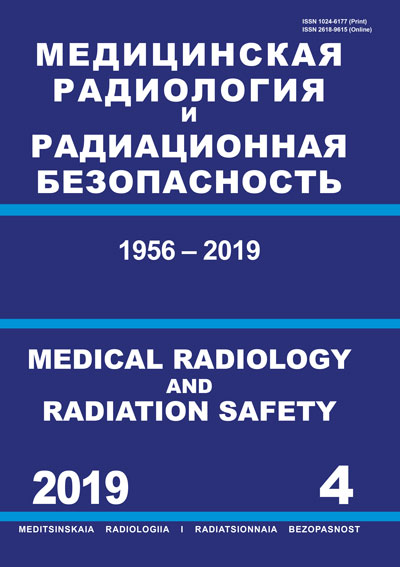Moscow, Russian Federation
Moscow, Russian Federation
Moscow, Russian Federation
Russian Federation
Russian Federation
CSCSTI 76.03
CSCSTI 76.33
Russian Classification of Professions by Education 14.04.02
Russian Classification of Professions by Education 31.06.2001
Russian Classification of Professions by Education 31.08.08
Russian Classification of Professions by Education 32.08.12
Russian Library and Bibliographic Classification 51
Russian Library and Bibliographic Classification 534
Russian Trade and Bibliographic Classification 5708
Russian Trade and Bibliographic Classification 5712
Russian Trade and Bibliographic Classification 5734
Russian Trade and Bibliographic Classification 6212
A 43-year-old man presented with a history of osteogenic sarcoma of lower third of the right femur bone. In dynamic monitoring (2011–2018) in the Nuclear Medicine Department of N.N. Blokhin National Medical Research Centre of oncology, Moscow, Russia a total of 48 radionuclide diagnostic studies were performed: 24 bone scans, 19 SPECT/CT (areas of interest) and 5 dynamic scintigraphies. The results of radionuclide diagnostics allowed to identify 6 episodes of progression of the underlying condition earlier than X-ray methods of imaging in the form of appearance of new metastases in bones, right lung and continued growth of some previously identified metastases in different periods of observation. Time between relapse detection and treatment ranged from 1 to 12 months. First of all it was because of the clinicians distrust to the results of radionuclide studies that were not confirmed by X-Ray at early stages. During the relapse treatment process patient received standard and innovative therapies: 10 courses of polychemotherapy, two surgeries for endoprosthesis replacement of the right knee and femur, upper lobectomy of the right lung, radiation therapy for metastasis in the left iliac bone (total boost dose – 52 Gy), radiation therapy on the CyberKnife device on metastases in the head of the 7th right rib and metastasis in the right lung, 2 sessions of ultrasonic thermal ablation on the HIFU in the area of metastases in the neck of the right femur,5 courses of bisphosphonates. The method of hybrid imaging of SPECT/CT allowed us to reliably monitor the effectiveness of the therapy. Postradiation changes in osteosarcoma metastases consisted in a decrease bone (pathological) metabolism, while radio-intensity indices did not change. For the first time we observed the effect of ultrasonic thermal ablation in the treatment of bone metastases. The effect of the treatment manifested very quickly and we visualized it as a defect of accumulation of radiopharmaceutical, which is a consequence of damage to the tumor vessels and tissue necrosis. In the observation of osteosarcoma recurrence SPECT with osteotropic radiopharmaceuticals demonstrates advantages over PET with 18F-FDG. Bone scan and SPECT/CT have proven to be reliable methods of dynamic control of a patient with osteosarcoma.
SPECT/CT, bone scan, osteosarcoma, CyberKnife, HIFU
Research description
Osteogenic sarcoma and its metastases are among the most difficult tumors in treatment. On the one hand we have the improvement of traditional methods of systemic treatment (chemotherapy), and the local methods of treatment, on the other hand, thus allow us to hope that the effectiveness of treatment will increase. Monitoring the state of the disease is carried out using functional imaging methods (bone scan, SPECT, PET) and anatomy imaging methods (CT, MRI). In the past two decades, the hybrid SPECT/CT imaging method is actively introduced into clinical practice. The cause of usage of various methods of diagnostics is the need to obtain information on the state of perfusion of the tumor tissue and cell function, and on the anatomical and morphostructural changes in the focus of the tumor lesion at the same time[1]. Regarding this, it is interesting to use hybrid SPECT/CT method in the diagnosis and control of treatment of osteosarcoma metastases.
1. Krzhivitsky PI, Kanaev SV, Novikov SN, Zhukova LA, Ponomareva OI, Negustorov YuF. SPECT-CT in the diagnosis of metastatic skeletal lesion. Problems in Oncology. 2014;60(1):56-63. (Russian).
2. Ryzhkov AD, Ivanov SM, Shiryaev SV, Krylov AS, Stanyakina EE, Kochergina NV, et al. SPECT/CT radiation in treatment of bone metastases of osteosarcoma. Problems in Oncology. 2016; 62(5):654-9. (Russian).
3. Ryzhkov AD, Shiryaev SV, Machak GN, Kochergina NV, ShchipakhinaYaA, Krylov AS, et al. SPECT/CT in Treatment Monitoring of Bone Metastases of Osteosarcoma with Ultrasound Thermal Ablation Method. Medical Radiology and Radiation Safety. 2016;61(5):54-8. (Russian).
4. Mebarki M, Medjahedi A, Menemani A, Betterki S, Terki S, Berber N. Osteosarcoma pulmonary metastasis mimicking abnormal skeletal uptake in bone scan: utility of SPECT/CT. Clin Nucl Med. 2013;38(10):392-4. DOI:https://doi.org/10.1097/RLU.0b013e318266cdcb.
5. TerHaar G. HIFU Tissue Ablation: Concept and Devices. Adv Exp Med Biol. 2016;880:3-20. DOI:https://doi.org/10.1007/978-3-319-22536-4_1.
6. Nasarenko AV, Ter-Arutyunyants SA Stereotactic radiation therapy (SRT) in the treatment of primary and metastatic bonelesions. Bone and Soft Tissue Sarcomas, Tumors of the Skin. 2016(1):36-44. (Russian).





